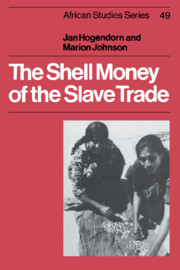Book contents
- Frontmatter
- Contents
- Maps
- Tables and chart
- Preface
- Introduction
- 1 The cowrie
- 2 The Maldive Islands
- 3 The Portuguese domination
- 4 The Dutch and English enter the trade (seventeenth century)
- 5 Prosperity for the cowrie commerce (eighteenth century)
- 6 Boom and slump for the cowrie trade (nineteenth century)
- 7 Collection, transport and distribution
- 8 Cowries in Africa
- 9 The cowrie as money: transport costs, values and inflation
- 10 The last of the cowrie
- Notes
- Bibliogaphy
- Index
1 - The cowrie
Published online by Cambridge University Press: 12 October 2009
- Frontmatter
- Contents
- Maps
- Tables and chart
- Preface
- Introduction
- 1 The cowrie
- 2 The Maldive Islands
- 3 The Portuguese domination
- 4 The Dutch and English enter the trade (seventeenth century)
- 5 Prosperity for the cowrie commerce (eighteenth century)
- 6 Boom and slump for the cowrie trade (nineteenth century)
- 7 Collection, transport and distribution
- 8 Cowries in Africa
- 9 The cowrie as money: transport costs, values and inflation
- 10 The last of the cowrie
- Notes
- Bibliogaphy
- Index
Summary
The “contemptible shells of the Maldives” which “prove the price of Mankind” are money cowries, Cypraea moneta. The word cowrie is taken direct from the Hindi and Urdu kauri and has a Sanskrit origin. The Latin name Cypraea derives from the island of Cyprus where Aphrodite (Venus) was worshipped as a goddess of fertility. Many peoples are said to have seen in the long slender orifice of the shell's underside the “one entrance into life,” in the delicate phrasing of Graf ton Elliott Smith. A cowrie worn around a woman's neck was supposed to promote conception and ease childbirth.
The little live gastropod is singularly unappealing at close quarters. Its tiny body, striped, somewhat dark in color and definitely slimy, appears to exude from its shell. It is an omnivore with graceless eating habits, consuming with its ribbon-like tongue (radula) algae, polyps, some corals, and animal detritus such as half-consumed fish or excrement. Sexes are separate, and reproduction efficient enough to supply vast quantities – entirely suitable for a fertility symbol. It is quite variable in size, adults ranging from less than half an inch to over an inch and a half in length. (The larger examples were always less acceptable as money because by boosting weight per unit they increased transport costs.) About three-quarters of an inch was a typical length for shells in the trade.
Young shells are toothless and have a large aperture on their underside that narrows with adulthood. The function of the teeth that line this aperture is uncertain, but possibly concerns feeding, cleaning, or the evasion of predators.
- Type
- Chapter
- Information
- The Shell Money of the Slave Trade , pp. 5 - 19Publisher: Cambridge University PressPrint publication year: 1986

